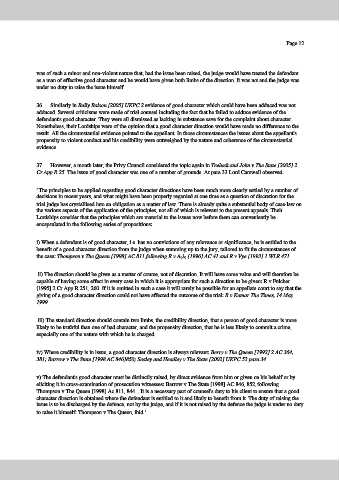Page 420 - Magistrates Conference 2019
P. 420
Page 12
was of such a minor and non-violent nature that, had the issue been raised, the judge would have treated the defendant
as a man of effective good character and he would have given both limbs of the direction. It was not and the judge was
under no duty to raise the issue himself.
36. Similarly in Bally Balson [2005] UKPC 2 evidence of good character which could have been adduced was not
adduced. Several criticisms were made of trial counsel including the fact that he failed to adduce evidence of the
defendant's good character. They were all dismissed as lacking in substance save for the complaint about character.
Nonetheless, their Lordships were of the opinion that a good character direction would have made no difference to the
result. All the circumstantial evidence pointed to the appellant. In those circumstances the issues about the appellant's
propensity to violent conduct and his credibility were outweighed by the nature and coherence of the circumstantial
evidence.
37. However, a month later, the Privy Council considered the topic again in Teeluck and John v The State [2005] 2
Cr.App.R 25. The issue of good character was one of a number of grounds. At para 33 Lord Carswell observed:
"The principles to be applied regarding good character directions have been much more clearly settled by a number of
decisions in recent years, and what might have been properly regarded at one time as a question of discretion for the
trial judge has crystallised into an obligation as a matter of law. There is already quite a substantial body of case-law on
the various aspects of the application of the principles, not all of which is relevant to the present appeals. Their
Lordships consider that the principles which are material to the issues now before them can conveniently be
encapsulated in the following series of propositions:
i) When a defendant is of good character, i.e. has no convictions of any relevance or significance, he is entitled to the
benefit of a good character direction from the judge when summing up to the jury, tailored to fit the circumstances of
the case: Thompson v The Queen [1998] AC 811 following R v Aziz [1996] AC 41 and R v Vye [1993] 1 WLR 471.
ii) The direction should be given as a matter of course, not of discretion. It will have some value and will therefore be
capable of having some effect in every case in which it is appropriate for such a direction to be given: R v Fulcher
[1995] 2 Cr App R 251, 260. If it is omitted in such a case it will rarely be possible for an appellate court to say that the
giving of a good character direction could not have affected the outcome of the trial: R v Kamar The Times, 14 May
1999.
iii) The standard direction should contain two limbs, the credibility direction, that a person of good character is more
likely to be truthful than one of bad character, and the propensity direction, that he is less likely to commit a crime,
especially one of the nature with which he is charged.
iv) Where credibility is in issue, a good character direction is always relevant: Berry v The Queen [1992] 2 AC 364,
381; Barrow v The State [1998 AC 846]850; Sealey and Headley v The State [2002] UKPC 52 para 34.
v) The defendant's good character must be distinctly raised, by direct evidence from him or given on his behalf or by
eliciting it in cross-examination of prosecution witnesses: Barrow v The State [1998] AC 846, 852, following
Thompson v The Queen [1998] Ac 811, 844. . It is a necessary part of counsel's duty to his client to ensure that a good
character direction is obtained where the defendant is entitled to it and likely to benefit from it. The duty of raising the
issue is to be discharged by the defence, not by the judge, and if it is not raised by the defence the judge is under no duty
to raise it himself: Thompson v The Queen, ibid."

